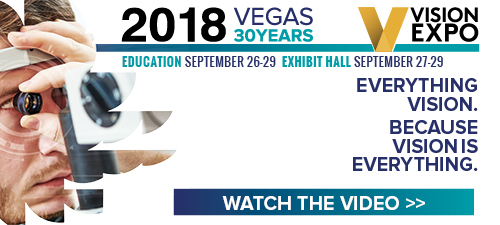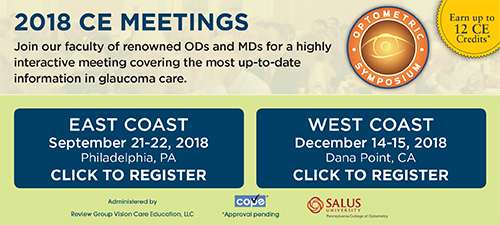
A
weekly e-journal by Art Epstein, OD, FAAO
Off the Cuff: South Africa – A Lesson in Contrasts
I am writing this from South Africa’s Kruger National Park in a cabin at Hamiltons Tented Camp, without cell or internet service. At first odd, the disconnect from the rest of the world has become enjoyable. The camp is within the largest game reserve in South Africa—one of the largest wildlife sanctuaries in the world. Being here is at once breathtaking and remarkable. While the optometric community here is willing and quite capable, these absurd and antiquated regulations deprive many of much needed care. The South African government should be embarrassed by these senseless and shortsighted policies. It’s time South African leaders focused on the wellbeing of their citizens rather than bureaucratic imperative.
|
|||||||
 |
||
| Gender Variation in Central Serous Chorioretinopathy | ||||
A retrospective comparison between male and female subjects with central serous chorioretinopathy (CSC) was completed to evaluate the presentation and outcomes of CSC between male and female subjects in different ethnic populations. Demographic details, clinical presentations, imaging features and treatment outcomes were compared at baseline and at last follow-up. This study included 155 male and 155 female subjects with a mean (CSD) age of 43.8 ± 10.3 and 57 ± 12.1 years, respectively, and a mean duration of follow-up of 8.49 ± 12.6 months. At presentation, there was no difference in visual acuity; however, visual acuity was significantly higher for female subjects at last follow-up. Optical coherence tomography (OCT) analysis showed that subretinal deposits, hyperreflective foci, retinal pigment epithelial detachment and retinal pigment epithelium (RPE) irregularities (p=0.03) were higher in male subjects at presentation. Angiographic analysis showed that diffuse leakage and RPE tracts were common in males. No significant differences in choroidal dilatation or diffuse choroidal leakages were noted. Female subjects with CSC appeared to have better outcomes, with less chances of diffuse RPE damage and other OCT features compared with males. |
||||
SOURCE: Hanumunthadu D, Van Dijk EHC, Gangakhedkar S, et al. Gender variation in central serous chorioretinopathy. Eye (Lond). 2018; Jul 9. [Epub ahead of print]. |
||||
 |
||
| Quantitative MRI Evaluation of Glaucomatous Changes in the Visual Pathway | ||||
The aims of this study were to investigate glaucomatous morphological changes quantitatively in the visual cortex of the brain with voxel-based morphometry (VBM), a normalizing MRI technique, and to clarify the relationship between glaucomatous damage and regional changes in the visual cortex of patients with open-angle glaucoma (OAG).
Thirty-one patients with OAG (age: 55.9 ± 10.7, male: female = 9:22) and 20 age-matched controls (age: 54.9 ± 9.8, male: female = 10: 10) were included in this study. The cross-sectional area (CSA) of the optic nerve was manually measured with T2-weighed MRI. Images of the visual cortex were acquired with T1-weighed 3D magnetization-prepared rapid acquisition with gradient echo (MPRAGE) sequencing. The normalized regional visual cortex volume, i.e., gray matter density (GMD) in Brodmann areas (BA) 17, 18 and 19 was calculated with a normalizing technique based on statistic parametric mapping 8 (SPM8) analysis. Researchers compared the regional GMD of the visual cortex in the control subjects and OAG patients. Spearman's rank correlation analysis was used to determine the relationship between optic nerve CSA and GMD in BA 17, 18 and 19. Researchers found that the normal and OAG patients differed significantly in optic nerve CSA and visual cortex GMD in BA 17, BA 18 and BA 19. In addition, they found a significant correlation between optic nerve CSA and visual cortex GMD in BA 19, but not in BA 17 or BA 18. Researchers concluded that quantitative MRI parametric evaluation of GMD could detect glaucoma-associated anatomical atrophy of the visual cortex in BA 17, 18 and 19. Furthermore, they found that GMD in BA 19 was significantly correlated to the damage level of the optic nerve, as well as the retina, in patients with OAG. As the first demonstration of an association between the cortex of the brain responsible for higher-order visual function and glaucoma severity, researchers wrote that evaluation of the visual cortex with MRI was, thus, a promising potential method for objective examination in OAG. |
||||
SOURCE: Fukuda M, Omodaka K, Tatewaki Y, et al. Quantitative MRI evaluation of glaucomatous changes in the visual pathway. PLoS One. 2018;13(7):e0197027. |
||||
|
|||
| Anatomical and Functional Dichotomy of Ocular Itch and Pain | ||||
Itch and pain are refractory symptoms of many ocular conditions, investigators wrote. Ocular itch is generated mainly in the conjunctiva and is absent from the cornea. In contrast, most ocular pain arises from the cornea. However, the underlying mechanisms remain unknown, investigators wrote further. Using genetic axonal tracing approaches, investigators discovered distinct sensory innervation patterns between the conjunctiva and cornea. Further genetic and functional analyses in rodent models showed that a subset of conjunctival-selective sensory fibers marked by MrgprA3 expression, rather than corneal sensory fibers, mediated ocular itch. Importantly, the actions of both histamine and nonhistamine pruritogens converged onto this unique subset of conjunctiva sensory fibers and enabled them to play a key role in mediating itch associated with allergic conjunctivitis. Investigators wrote that this phenomenon is distinct from skin itch in which discrete populations of sensory neurons cooperate to carry itch. Finally, investigators provided proof of concept that selective silencing of conjunctiva itch-sensing fibers by pruritogen-mediated entry of sodium channel blocker QX-314 was a feasible therapeutic strategy to treat ocular itch in mice. Itch-sensing fibers also innervated the human conjunctiva and allowed pharmacological silencing using QX-314. Investigators suggested that the results cast new light on the neural mechanisms of ocular itch and opened a potential new avenue for developing therapeutic strategies. |
||||
SOURCE: Huang CC, Yang W, Guo C, et al. Anatomical and functional dichotomy of ocular itch and pain. Nat Med. 2018; Jul 9. [Epub ahead of print]. |
||||
 |
||
| News & Notes | ||||||||
BlephEx Names Ellis CEO |
||||||||
Eton Pharma Reports Positive Topline Results from Phase III EM-100 Trial
|
||||||||
| IDOC Launches The Connection National Conference IDOC announced its national conference in Chicago, The Connection, to showcase its broad industry leadership and unique solutions for independent ODs to build successful, thriving practices at every stage of business. The conference will be held August 15 to 18 at the Swissôtel in Chicago. Attendance is complimentary for IDOC members, and this year, IDOC is also offering complimentary registration for third- and fourth-year optometry students and independent optometrists who are not currently members of IDOC. Learn more.
|
||||||||
|
Optometric Physician™ (OP) newsletter is owned and published by Dr. Arthur Epstein. It is distributed by the Review Group, a Division of Jobson Medical Information LLC (JMI), 11 Campus Boulevard, Newtown Square, PA 19073. HOW TO ADVERTISE |






